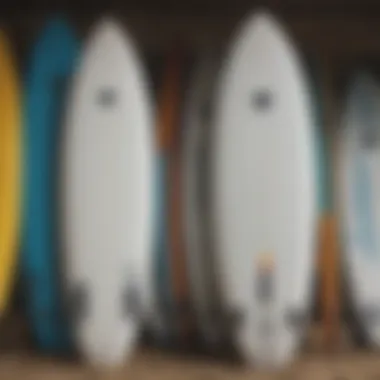Exploring Battery-Powered Surfboards: Technology and Impact


Intro
In recent years, surfing has gone through a notable transformation, combining the thrill of catching waves with the innovation provided by technology. Among the most significant advancements is the introduction of battery-powered surfboards. These modern devices are altering the face of watersports, merging traditional surfing techniques with electric propulsion. It poses an exciting prospect for both beginners and seasoned surfers alike, offering a unique spin on how to enjoy the ocean.
Battery-powered surfboards are not just about surfing differently; they’re a response to changing environmental dynamics and a quest for accessibility. Whether it’s for enthusiasts who want to ride waves in less than ideal conditions or for those trying to carve their path in areas where traditional surfing might be challenging, these boards are opening up new avenues.
Essentially, this article will explore the intricate details surrounding battery-powered surfboards—from their evolution to their practical applications, and even user experiences. You may ask: how do they work? Is it safe? How do they compare to traditional boards? These are vital questions that deserve attention, especially for watersports enthusiasts and outdoor adventurers who are always looking for the next challenge. Let's dive in!
Preface to Battery-Powered Surfboards
As we surf through the waves of modern technology, battery-powered surfboards have carved out a notable niche in the world of water sports. Their rise signifies a progressive shift not only in how we engage with the ocean but also in how we conceive the sport of surfing itself. These boards bring forth a meld of innovation and adventure, allowing riders to explore previously unreachable territories or ride on calmer waters with ease.
The Concept Behind Electric Surfboards
The essence of electric surfboards lies in their unique amalgamation of traditional surfing dynamics with cutting-edge technology. Unlike their conventional counterparts, these boards utilize electric motors and battery systems to provide propulsion. This innovation can dramatically alter the surfing experience, whether it’s slicing through waves or gliding on smooth bays.
With the press of a button or a twist of a throttle, riders can harness the power of electric drive, enabling longer rides without exhausting oneself. A typical paddle might wear one out before even reaching the waves, but electric surfboards flatten that learning curve.
The design often includes intuitive controls, making it accessible for both seasoned professionals and novice surfers. As a result, those who may have found themselves out of their depth can now participate without feeling overwhelmed by physical demands. Moreover, riding these boards can be an exciting entry point into the world of surfing, sparking interest and participation in the sport from a broader audience.
A Brief History of Surfboard Innovation
To understand the significance of battery-powered surfboards, it helps to take a step back and glance at the historical progression of surfboard design.
- The Early Days: Originally, polished wood was the material of choice for surfboards, which offered limited buoyancy and maneuverability.
- Foam Revolution: In the 1960s, the introduction of foam-core boards radically changed the game. They were lighter, more buoyant, and easier to handle.
- Design Innovations: As styles evolved, manufacturers began experimenting with different shapes, materials, and lengths, catering to various surfer needs.
Then, enter the electric surfboard into this timeline. The concept isn’t very old; it gained traction in the early 2000s as surfers began seeking new thrills. These boards combine aesthetic design with high-performance technology. It's a reinvention born of necessity, aimed at pushing the boundaries of where and when one can surf.
With every technological leap, surfing evolves, becoming more than just a sport – it transforms into an experience that merges tradition with futuristic elements. It's not just about riding the waves anymore; it’s about embracing innovation and exploring off-the-beaten-path locales with newfound ease.
Battery-powered surfboards represent not only a leap in surfing technology but also a gateway into broader participation in the sport, inviting a new generation of surfers into the fold.
In sum, electric surfboards have an exciting backstory fueled by ambition and creativity. This ongoing evolution inspires and energizes both seasoned surfers and curious newcomers, paving the path for a new era in surf culture.
Understanding the Technology
Understanding the technology behind battery-powered surfboards is crucial for anyone looking to make an informed decision about their use. This section dives into the layers of technology that power these innovative boards. It covers battery systems, motors, and the resilience against water, all of which combine to enhance the surfing experience. By grasping these elements, users can better appreciate the engineering feats that enable the sport to evolve while maximizing performance and addressing environmental concerns.
Battery Systems and Power Output
The heart of any battery-powered surfboard is the battery itself. Generally, lithium-ion batteries are the preferred choice, and for good reason: they're light, rechargeable, and pack a powerful punch. Power output varies widely, but many modern surfboards offer between 4 to 15 horsepower. This translates to significant thrust, allowing riders to zip through waves with far less effort than traditional paddling would require.
Key points to consider:
- Capacity: Battery capacity, typically measured in amp-hours, determines how long you can ride before needing a recharge. A higher capacity means more riding time, which is often a prime concern for enthusiasts.
- Charge Time: Depending on the size, charging a surfboard battery might take anywhere from 1 to 8 hours. Fast-charging features are a plus but can sometimes compromise battery life.
- Weight Distribution: A well-placed battery enhances balance on the board. Manufacturers pay careful attention to positioning the battery for optimal handling, making the board feel less cumbersome in the water.
Motor Types and Their Efficiency
Diving into motor types provides insight into performance and efficiency. Generally, electric surfboards utilize brushless DC motors. These are favorable due to their quiet operation and higher durability. In terms of efficiency, the ratio of energy consumed to thrust produced depends on various factors such as motor size and design.
Types of Motors:
- Inrunner Motors: Generally compact and lightweight, these offer higher speeds and are commonly found in many electric surfboards.
- Outrunner Motors: Though bulkier, they can deliver a higher torque, making them suitable for boards designed for rougher waves.
- Hybrid Systems: Combining both inrunner and outrunner elements, hybrid systems often strike a balance between speed and torque but are less common.
Effective motor selection influences top speed and how responsive the board feels, ensuring that even novice riders can experience an exhilarating ride without losing control.
Water Resistance and Durability
Maintaining functionality while being splashed repeatedly by waves is no small feat. Therefore, construction material and design are paramount in creating surfboards that can withstand the elements. Most boards have a waterproof casing that protects the internal components from saltwater exposure, which can wreak havoc if left unchecked.


Crucial factors include:
- Materials Used: High-density foam or specialized composite materials make the boards light yet resilient. Carbon fiber, while more expensive, offers robustness without adding weight.
- Sealing Mechanisms: Ingeniously designed seals prevent water ingress, ensuring that the components remain fully functional throughout their lifespan.
- Maintenance Needs: Keeping the board clean and checking for wear and tear is vital for longevity. Salt residue can become a slippery slope—quite literally, if not addressed promptly.
"Battery-powered surfing is not just about enjoying the waves; it’s about harnessing technology to redefine aquatic adventures."
For further insights on electric surfboards, feel free to browse related articles on Wikipedia, Britannica, or check out discussions on Reddit.
Design Considerations
In the realm of battery-powered surfboards, the design parameters demand a careful balance between aesthetics and functionality. Designing a surfboard isn't merely about slapping a battery and motor onto a traditional shape; it’s a nuanced task that can affect performance, rider stability, and overall enjoyment on the water. A surfboard's design plays a pivotal role in how seamlessly it integrates electric power while still delivering a surfing experience that feels authentic.
Shape and Stability
The shape of a battery-powered surfboard is critical to its performance. Surfboards typically come in different shapes like fish, shortboards, and longboards, and the choice of shape can dramatically impact how the board handles in the water. For instance, a board with a wider nose and tail will usually be more stable, which is an essential factor for beginners who are just getting the hang of riding.
Electric surfboards also benefit from a design that minimizes drag while providing enough volume for buoyancy, especially given the added weight of the battery system. Consider the channeling on a board's bottom: it allows water to flow more smoothly, enhancing speed and glide without compromising stability. A surfer who feels stable is more likely to enjoy their ride, leading to longer sessions and improved skills over time.
Weight Distribution and Handling
With battery-powered surfboards, weight distribution can be the make-or-break element. The placement of the battery and motor directly affects how the board behaves on water. If the weight is concentrated in one area, it can make the board feel heavy and unresponsive, leading to a frustrating experience. Conversely, a well-balanced surfboard, where the battery is strategically placed, can enhance maneuverability and responsiveness.
For many riders, intuitive handling can be as enjoyable as the thrill of riding the waves. When the board feels light and responsive, the rider can assert greater control, allowing for sharp turns and rapid acceleration.
Customization Options
The beauty of battery-powered surfboards lies in their potential for customization. Riders can personalize their boards to suit their needs, preferences, or riding styles. For instance, one might opt for a stronger motor for quicker speeds, while another might prioritize a lightweight build for effortless handling.
Customization can extend beyond just performance tweaks. Design choices such as graphics, colors, and shapes enable surfers to express their individuality on the water, transforming a simple surfboard into a canvas of self-expression.
- Performance Customizations: Higher power output, battery capacity, motor type.
- Aesthetic Personalizations: Custom graphics, unique shapes, color schemes.
- Functional Enhancements: Adding rails for better grip, different fin configurations.
"Every detail in a board's design speaks to its capabilities; it’s not just a tool, but an extension of the rider themselves."
Performance Analysis
Performance analysis is vital in evaluating battery-powered surfboards not only for their functionality but also for user satisfaction. By understanding how these boards perform in various conditions, we can appreciate the nuances that differentiate them from traditional surfboards. This section breaks down three core elements: speed and agility, rider experience and control, and how they stack up against the conventional boards.
Speed and Agility
Battery-powered surfboards have taken surfing into a different stratosphere. Their speed can be exhilarating. Most electric surfboards reach speeds up to 30 mph, offering a thrilling ride that traditional boards can't compete with. Imagine zipping across the waves, the wind rushing past, feeling adrenaline surge through you.
But it's not just about neck-breaking speeds. The agility of these boards also sets them apart. Their design allows for sharp turns and quick maneuvers, which is crucial when catching waves or navigating choppy waters. For instance, a user can carve a sharp line in the water thanks to the lightweight materials and powerful motors. This adaptability makes battery-powered surfboards appealing to both novices looking to learn the ropes and seasoned pros eager for a new challenge.
Rider Experience and Control
User experience cannot be overlooked when discussing performance. Riders frequently mention how intuitive the controls are. Most boards come with wireless remotes that allow for smooth acceleration and deceleration, putting riders in the driver’s seat—literally. They can fine-tune their pace with a flick of their wrist, which creates a sense of freedom previously uncharted in surfing.
The importance of balance also needs to be highlighted here. As riders become more adept, they report an enhanced feeling of stability, which is crucial for confidence. Many reviews note that even beginners find it easier to maintain control on battery-powered boards compared to their traditional counterparts, where weight distribution can be trickier. Riders can focus more on their technique rather than worrying about staying afloat.
Comparison with Traditional Surfboards
When placing battery-powered surfboards side by side with traditional ones, the differences becomes glaringly obvious. Traditional surfing, with its reliance on wave energy and physical paddling, often demands a steeper learning curve. In contrast, electric surfboards equip riders with the means to harness speed without the need for perfect wave conditions.
- Speed: As mentioned earlier, electric surfboards can hit remarkable speeds in flat water, while traditional surfboards rely on oceanic swells.
- Accessibility: Those just starting their surf journey can gain confidence on electric boards faster than they might on a standard surfboard, considering they don't have to fight against the wave's pull.
- Portability: Electric surfboards can often be brought out in varied conditions, allowing for more flexibility in where one can ride. This is a significant advantage for those without access to consistent surf spots.
By analyzing performance through these lenses, it becomes clear that battery-powered surfboards are not just a fad; they bring serious advantages to the table. They merge the thrill of surfing with cutting-edge technology, reshaping the way enthusiasts experience the sport. Overall, the performance analysis indicates that electric surfing can cater to a broader range of skill levels and preferences, emphasizing inclusivity in water sports.
"Electric surfboards unlock opportunities that have remained latent for surfers willing to push boundaries."


In understanding these dynamics, riders can be more informed about their choices, making sure they pick the board that suits their style and needs best.
Benefits of Battery-Powered Surfboards
In the realm of water sports, battery-powered surfboards are making some serious waves. They aren't just novelty items; they carry a range of practical benefits that cater to both seasoned surfers and curious newcomers. As we ride this technological tide, let's delve deeper into three essential advantages that highlight the transformative potential these devices have in the surfing world.
Extended Riding Time
One of the standout features of battery-powered surfboards is their extended riding time. Unlike traditional surfboards, where riding is often dictated by wave conditions and individual stamina, electric surfboards provide a different playbook. With top-tier battery systems, surfers can glide over the water for up to two hours on a single charge, depending on factors like speed and wave conditions. This extended runtime opens the door to a more immersive surfing experience.
The freedom to stay out longer is particularly appealing in locations where waves can be inconsistent. Imagine driving for hours to a gorgeous beach only to find the surf cooperative for mere minutes before a lull sets in. With a battery-powered surfboard in tow, the thrill continues, allowing riders to cover greater distances and explore new waters.
Accessibility for Beginners
Another significant advantage is the accessibility they offer to beginners. The learning curve for surfing can be steep. Electric surfboards help flatten that curve considerably. The added support from the electric motor assists novice riders in maintaining speed and balance, effectively lowering the barrier to entry.
Here are some key points on accessibility:
- Consistent Speed: Beginners often struggle with self-propelling and maintaining speed. The motor gives a helping hand, enabling smoother rides.
- Less Physical Strain: The strain experienced by those still honing their skills can be reduced, as they don't have to rely solely on their paddling strength. This means they can focus on technique rather than fatigue.
- Confidence Building: Feeling secure and stable on the board can boost confidence. With fewer wipeouts and more successful rides, learners are likely to enjoy the process more.
Eco-Friendly Innovations
Battery-powered surfboards represent a shift towards eco-friendly innovations in an industry often criticized for its environmental impact. Traditional surfboard materials and the mechanics of gas-powered motors can take a toll on our oceans. Electric surfboards, on the other hand, provide a cleaner alternative.
Here's what makes them eco-conscious choices:
- Zero Emissions: These surfboards run quietly and cleanly, minimizing disturbances to marine life. They utilize electric engines that don’t emit harmful exhaust, supporting healthier oceans.
- Sustainable Materials: Many manufacturers are beginning to prioritize recyclable or biodegradable materials in their board designs, reducing overall waste and fostering sustainability.
- Energy Efficiency: While charging requires electricity, advancements in renewable energy sources, like solar power, further minimize their carbon footprint.
"The evolution of surfboards has not just been about performance but about our responsibility to the oceans we cherish."
In summary, the benefits of battery-powered surfboards are undeniable. They stretch riding times, make surfing more accessible to novices, and promote an eco-friendly ethos essential for the future of water sports. Whether you're an experienced surfer or someone eager to dip your toes into the ocean for the first time, these innovations create a thrilling, sustainable surfing experience for all.
Safety Considerations
The world of battery-powered surfboards opens a new chapter in watersports, but it comes with its own set of safety considerations. Understanding these aspects ensures a safe and enjoyable experience for riders. Firstly, user protection is paramount. These boards can reach impressive speeds, and the dynamics of riding can be different from traditional surfboards. It’s essential for riders to be aware of their surroundings on the water, especially in crowded areas or rough conditions.
To help mitigate risks, wearing appropriate safety gear is crucial. Riders should not underestimate the importance of helmets, buoyancy aids, and wetsuits. While the thrill of surfing can take priority, protection should always be at the forefront of every ride. Additionally, proper maintenance and checks of the surfboard before venturing out can prevent unforeseen mishaps.
Taking safety seriously is not just about gear; it’s about being a responsible rider.
Beyond personal safety precautions, being informed about local regulations also plays a significant role in ensuring that riding a battery-powered surfboard is both safe and considerate to others in the water. Understanding these guidelines is vital to promote a culture of safety among the surfboarding community.
Safety Gear and Accessories
Safety gear forms the foundation of a secure surfing experience. Here are some essentials:
- Helmet: Protects the head during falls or collisions with other surfers or objects.
- Impact Vest: Provides added buoyancy and reduces the risk of injury from falls.
- Wetsuit: Not only keeps the rider warm in cooler waters but also offers a layer of protection against abrasions.
- Leash: Ensures that the board remains connected to the rider, preventing it from becoming a hazard to others.
Investing in quality gear can make a significant difference. For instance, helmets designed specifically for water sports are lighter but offer superior impact resistance. Always opt for well-reviewed and tested products from reputable brands.
Regulations and Compliance
Navigating the waters of battery-powered surfboarding is not just about having fun; it's about adhering to established regulations. Local laws regarding powered watercraft can vary greatly, and understanding these rules is essential.
Some key regulations include:
- License Requirements: Depending on the area, riders may need specific permits or licenses to operate battery-powered surfboards.
- Restricted Areas: Certain water bodies may have restrictions on powered devices. Knowing where one can surf legally ensures a smoother experience.
- Noise Regulations: Electric surfboards can be quieter than traditional engines but might still need to comply with noise regulations in some regions.
Ensuring compliance not only protects the rider from fines but also helps foster a positive relationship with other water users and preserves the environment. For further insights, consult local authorities or surfing communities on platforms like reddit.com or related Facebook groups.


User Experiences and Feedback
User experiences play a pivotal role in understanding the real-world performance and practicality of battery-powered surfboards. These narratives often reflect the genuine insights of riders on the waves, providing a unique perspective that goes beyond mere technical specifications. Feedback from users highlights both the triumphs and challenges of integrating electric technology into traditional surfing practices. Moreover, these testimonials give potential buyers an idea of what they might expect in their own surfing ventures. As the popularity of these boards rises, the collective wisdom of seasoned and novice users alike can foster a clearer outlook for future advancements in this field.
Testimonials from Users
Personal accounts from users reveal how battery-powered surfboards have enhanced their surfing experience. For example, one user, a surfer named Alex, shared that riding his electric surfboard allowed him to effortlessly coast over longer distances without exhausting himself. "I felt like I could ride the waves all day long!" he exclaimed. This sentiment is echoed by many who appreciate the extended riding time these boards offer compared to traditional counterparts.
Other testimonials highlight the thrill of speed and agility. For instance, a rider named Jenny reported, "I've never felt so connected to the water. It's like flying just above the surface!" Such feedback illustrates the boards’ capacity to attract not only surfers but also adventurous newcomers who seek an exhilarating experience.
Beyond enjoyment, users also express awareness of their environmental impact. Many highlight how opting for battery-powered surfboards helps reduce reliance on gas-powered jet skis or boats, making it a greener choice. As Jake, a surfer from California, noted, "It feels good knowing I’m part of a change toward sustainability in watersports."
Challenges Encountered
However, embracing this innovation isn't without its hurdles. Some users report issues with battery life, expressing frustration during long sessions. "The first two hours are phenomenal, but you better hope there are no unexpected waves afterward; you may find yourself paddling back," stated Miguel, a frequent user. This highlights a critical point; without sufficient battery power, the exhilaration can quickly turn into a race against the tide.
Additionally, there are concerns regarding maintenance and durability. Riders like Sarah have encountered technical glitches or components that wear down faster than expected. "It can be a bit of a chore, keeping everything in check. I just want to ride!" she shared. This candid feedback emphasizes an area where manufacturers might focus on improving reliability and reducing upkeep requirements in future models.
In sum, user feedback encapsulates a blend of elation and real-world challenges.
"It's exhilarating but comes with its quirks—like any tech. The trick is embracing both and finding joy in the ride!"
The insights offered by these individuals not only enrich the narrative around battery-powered surfboards but also indicate a communal learning process as both riders and innovators strive for better experiences on the waves.
Future Trends in Surfboarding Technology
The world of surfing is not simply about catching waves anymore; it is rapidly evolving with advancements that integrate technology into the sport. Battery-powered surfboards stand at the forefront of this transformation. This section tackles the future trends that are shaping these innovations, particularly focusing on market growth predictions and upcoming breakthroughs that could enhance surfing experiences further. Automation and smart features are among the most exciting prospects that surfers now take into account, aiming to marry luxury with thrill in ways that were once reserved for fantasy.
Predictions for Market Growth
The market for battery-powered surfboards is projected to grow exponentially over the next decade. Research suggests that as the environmental awareness rises globally, more consumers will prefer eco-friendly options. This has led to an increase in the number of manufacturers developing new electric surfboards. Factors contributing to this predicted growth include:
- Rising Popularity: The appeal of battery-powered surfing is growing especially among beginners who wish to learn without the steep learning curve associated with traditional surfing.
- Sales Projections: Experts predict that by 2030, the industry could witness a revenue increase of more than 30% annually.
- Diverse Applications: These boards aren’t just for thrill-seekers; they’re also proliferating applications in fitness, leisure activities, and even competitive surfing events, expanding their reach to a wider audience.
"With electric surfboards making waves, it’s a matter of time before they become as common as their traditional counterparts."
Potential Innovations on the Horizon
As we look ahead, several key innovations could redefine the surfing landscape. The tech world is brimming with manageable yet sophisticated developments aimed at enhancing the surfing experience, including:
- Smart Technology Features: Imagine a surfboard that could communicate performance metrics live—speed, distance, battery life—right to an app on your phone. Integration of apps that offer tips or track your progress will make for a richer user experience.
- Enhanced Battery Technology: Future surfboards may see batteries that last longer while charging faster, encouraging even longer rides without worrying about running out of juice.
- Lightweight Materials: The hunt for materials that reduce weight without sacrificing durability is ongoing. New composites or possibly integrating low-weight metals could reshape the physical character of these boards.
- Sustainable Practices: As consumer demand leans towards sustainability, innovations may focus on utilizing recycled materials for board construction. This trend taps into a growing market of eco-conscious customers eager to minimize their environmental footprint.
The anticipated blend of technology and surfing paints an exciting picture ahead for battery-powered surfboards. As these innovations roll out, surfing may not only expand its appeal to a broader audience but could also redefine how we perceive water sports as a whole.
Epilogue
Battery-powered surfboards represent a notable shift in the surfing experience, merging technology with traditional water sports. The importance of this topic cannot be overstated, especially as we navigate a world increasingly preoccupied with sustainability and convenience. It sheds light on how these innovations not only elevate performance but also cater to a wider demographic of water enthusiasts.
Summarizing Key Insights
In scrutinizing the various sections of this article, a few crucial points emerge:
- Innovation in Surfing: Battery-powered surfboards feature cutting-edge technologies that enhance speed and maneuverability, changing the landscape of the sport for both professionals and beginners alike.
- Accessibility and Inclusivity: These surfboards break down barriers for newcomers to the sport, making it easier for individuals of varied skill levels to enjoy the ocean without needing to master traditional paddling techniques.
- Environmental Considerations: With strides toward eco-friendly designs, these devices minimize pollution in waterways and support the movement toward sustainable surfing practices. The incorporation of lithium-ion batteries is a significant factor in this green shift.
"The fusion of tradition and technology isn't just the future of surfing; it's the wave that's already rolling in."
Knowing these key insights arms readers with a deeper understanding of how battery-powered surfboards are reshaping surfing. Enthusiasts can appreciate the advantages they bring while also recognizing the ongoing challenges and considerations surrounding their widespread adoption.
The Road Ahead for Battery-Powered Surfboards
Looking forward, the trajectory for battery-powered surfboards is promising, yet not without potential hurdles. Several aspects and possibilities deserve attention:
- Continued Technological Innovations: As battery technology advances, we can anticipate lighter, longer-lasting batteries that will further increase ride times and boost performance.
- Broader Market Adoption: With an upward trend in market interest, we may soon see a diverse range of models suited for different types of riders, from novices to seasoned surfers.
- Enhanced Safety Measures: As more surfers embrace this technology, regulations and safety standards will likely evolve, ensuring that both the equipment and the sport maintain a high level of safety for users.
In summary, the future of battery-powered surfboards holds endless possibilities, from sustaining the environment to broadening access to the sport. This evolving narrative shapes not just an individual hobby but a collective lifestyle aimed at preserving marine life while enjoying the thrill of surfing. The marriage of technology and tradition is poised to redefine what it means to ride the waves.















